- News
- Reviews
- Bikes
- Accessories
- Accessories - misc
- Computer mounts
- Bags
- Bar ends
- Bike bags & cases
- Bottle cages
- Bottles
- Cameras
- Car racks
- Child seats
- Computers
- Glasses
- GPS units
- Helmets
- Lights - front
- Lights - rear
- Lights - sets
- Locks
- Mirrors
- Mudguards
- Racks
- Pumps & CO2 inflators
- Puncture kits
- Reflectives
- Smart watches
- Stands and racks
- Trailers
- Clothing
- Components
- Bar tape & grips
- Bottom brackets
- Brake & gear cables
- Brake & STI levers
- Brake pads & spares
- Brakes
- Cassettes & freewheels
- Chains
- Chainsets & chainrings
- Derailleurs - front
- Derailleurs - rear
- Forks
- Gear levers & shifters
- Groupsets
- Handlebars & extensions
- Headsets
- Hubs
- Inner tubes
- Pedals
- Quick releases & skewers
- Saddles
- Seatposts
- Stems
- Wheels
- Tyres
- Health, fitness and nutrition
- Tools and workshop
- Miscellaneous
- Tubeless valves
- Buyers Guides
- Features
- Forum
- Recommends
- Podcast
review
£1,749.00
VERDICT:
Race-bred carbon machine boasting lively but confident handling, low weight and a very impressive turn of speed
Weight:
7,760g
Contact:
www.hargrovescycles.co.uk
At road.cc every product is thoroughly tested for as long as it takes to get a proper insight into how well it works. Our reviewers are experienced cyclists that we trust to be objective. While we strive to ensure that opinions expressed are backed up by facts, reviews are by their nature an informed opinion, not a definitive verdict. We don't intentionally try to break anything (except locks) but we do try to look for weak points in any design. The overall score is not just an average of the other scores: it reflects both a product's function and value – with value determined by how a product compares with items of similar spec, quality, and price.
What the road.cc scores meanGood scores are more common than bad, because fortunately good products are more common than bad.
- Exceptional
- Excellent
- Very Good
- Good
- Quite good
- Average
- Not so good
- Poor
- Bad
- Appalling
From its second outing onwards the Stevens Izoard was casually referred to as 'Fast Eddy'. Eddy Izzard, right? Okay, I know, the Col D'Izoard is a famous alpine climb, and I'm happy to acknowledge my vintage by saying I was lucky enough to be spectating at the roadside when Lucien Van Impe crested it first in the 1976 Tour de France, but the double entendre is appropriate for a bike that conspired to temporarily switch my ride settings from vague meanderer to marathon man and depilate my legs for the first time in a decade.

Sticking with the abstract, a ride colleague ('Man in Black') insisted on calling the Izoard 'the hairdresser's bike' because of its colour scheme. Well, each to his own. I'm not normally a white bike person either, and would certainly steer well clear of white and yellow Lycra. I'm also not especially seduced by frames and forks covered in technoid graphics/acronyms. For those easily impressed the Stevens includes 'HMC High Modulus Carbon' on the top tube, 'System RC Reinforced Core' on the chain stays, 'SL Team Team Technology Stevens' on the seat stays, 'Carbon Monocoque 2 Tube Hybrid Technology' on the seat tube, 'tapered HEAD tube' on the head tube, 'M-Blade' on the fork, 'Pressfit BB86 Integrated System' on the bottom bracket and, on the down tube, a tidy 'Designed and Engineered in Hamburg' plus a big yellow Stevens graphic on the underside especially for photographers lying on the ground.
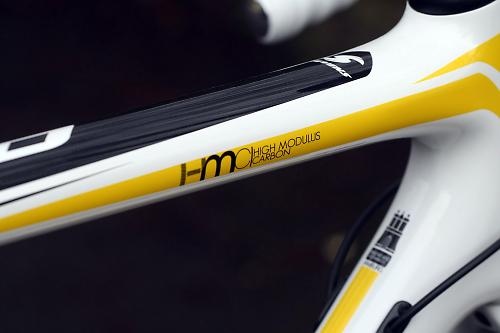
Fortunately the performance of the Izoard soon made up for any visual clutter qualms. From a purely personal viewpoint, it's unusual for a sub £2000 race-bred bike to instantly impress me as much as the Izoard did: I generally prefer road bikes with slightly slacker geometries and bigger treads than the 23mm offerings fitted here. But the Izoard chassis build and parts choices combine to provide a remarkably confident ride that feels far more compliant on rough roads than more costly race-bred machines while at the same time producing the potent speed squirts and sprightly handling that make race thoroughbreds stand out from also-rans. And it has room for slightly bigger treads if you wish. In fact, the only change I'd initially make would be to fit 25mm tyres that offer a smoother ride and a better grip in the wet than the Mavic Aksions fitted.

The test period was predominantly a two week stint riding out from Soller in Majorca. Anyone who's ridden from there will know that this means loads of climbing, with the heart, lungs, legs and bike performance being constantly challenged by the competitive surging of large German holiday groups riding similarly priced compatriot rental bikes from Cube, Focus and Merida.
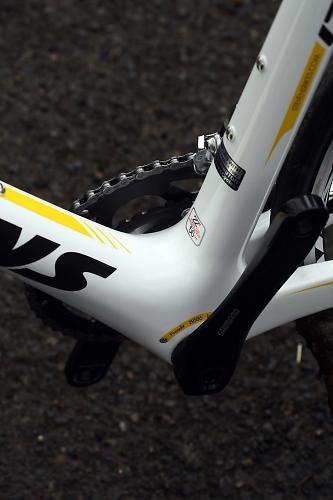
Fortunately the Stevens showed itself to be pretty nifty up the hills, leaving only myself to blame for losing the occasional wheel-holding battle.

Obviously the Izoard's all-in weight helps: at 7.76kg (17.1lb) it's competing for bantomweight status with bikes that can cost you twice as much. That's pretty impressive considering the middle-budget wheels and lack of carbon finishing kit. Stevens uses a Triton Oxygen saddle and a house branded 'Scorpo' seat post, stem and handlebar to trim a few costs, leaving the performance, weight and build quality focus on the high modulus carbon frame and fork. A decent overall spec list includes Mavic's entry level but decent performing Aksium S wheels and tyre package and a near complete Shimano Ultegra drivetrain... the crankset is Shimano's non-group-tagged R565 50/34 offering.
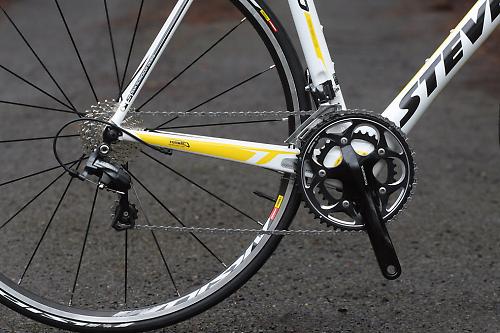
It's not hard to see where the speed comes from in the frame design. A close look at the massively supported profile of the BB86 bottom bracket explains a lot about the instant drive power when sprinting and climbing. A tapered head tube and the 'M-Blade reinforced core' fork keeps the handling rock-steady on fast descents and rough surfaces while the skinny seat stays appear to add a little extra comfort to the slimline but well padded saddle. Obviously saddle or handlebar shape is always going to be down to personal preferences, but the two other riders who tried the Izoard both backed up my own feeling that few riders looking for comfort and performance would object to Stevens' choices.

Stevens is a German brand, distributed in the UK by Hargroves Cycles. The Izoard's claimed frame weight is 1100g (2.43lb) and it's the 'entry level' model in the carbon race bike range. There are plenty of cheaper carbon framed bikes on the market but not many that come this well equipped or this light for this price. The tube profiling creates an ideal blend of stiffness and comfort while the tapered head tube, a press-fit bottom bracket and carbon dropouts give it the air of a top end race bike without the inflated price tag that some boutique brands attract.

A few of the smaller details are worthy of mention too: internal cables are easy to thread, with a full outer to the rear brake sheathed through the top tube and gear inners emerging from the down tube under the bottom bracket. Stevens also fits rubber guards to protect the paintwork from cable rub and Jagwire gear cable adjusters, easy to turn with one hand while riding, where the gear outers emerge from the bar tape. A tough metal-foil guard on the chainstay helps to protect the frame from damage if you drop the chain.
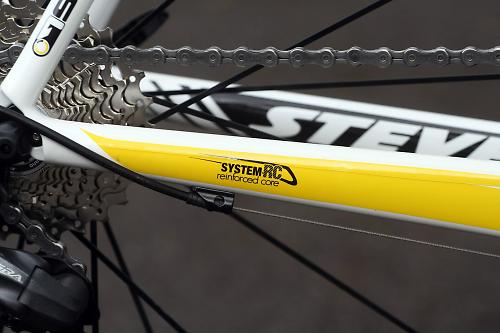
The core beauty of the Izoard is that, while it's a well thought out package just as it is, the quality carbon frameset also makes it a superb basis for later heft trimming and performance enhancing upgrades. A classier wheelset could be enough to nudge its speed and handling potential up to pro race bike levels.

The test bike, listed as a 56cm (sizes range from 50-62cm), has a horizontal top tube reach of 55.5cm. While the short head tube suggests race breeding, there's an inch stack of steerer washers to play with and you could also flip the stem the other way up if you like a high bar position. The geometry is at the steeper end of the race bike spectrum, 73.5 degrees parallel, with stem length and bar width corresponding to frame size (110mm stem and 420mm bars on this 56). The crank arms are 170mm on sizes 50 to 58, 175mm on the two larger sizes.
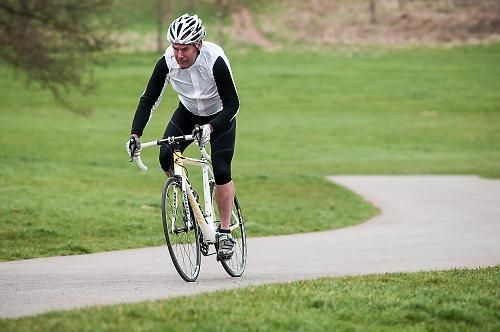
You'll find a fair few better equipped bikes around this price, notably from the brands that sell direct to the consumer, but not many of them offer frames as good as this. A lot of full carbon bikes from the big brands have Shimano 105 based groupsets.
Verdict
Race-bred carbon machine boasting lively but confident handling, low weight and a very impressive turn of speed.
road.cc test report
Make and model: Stevens Izoard (2013)
Size tested: 56cm
About the bike
State the frame and fork material and method of construction. List the components used to build up the bike.
High Modulus Carbon frame and fork
Mavic Aksion Wheels/tyres, Shimano Ultegra Brakes, Shifters and gear mechs, Compact non groupset crankset, Scorpo handlebar, stem and seatpost, Triton Oxygen saddle,
Tell us what the bike is for, and who it's aimed at. What do the manufacturers say about it? How does that compare to your own feelings about the bike?
It's a race bred all rounder that handles confidently enough to serve well as a go anywhere, have a go at anything speed bike.
Frame and fork
Overall rating for frame and fork
9/10
Tell us about the build quality and finish of the frame and fork?
Superb.
Tell us about the materials used in the frame and fork?
High Modulus carbon, would be very much at home on a much more costly bike.
Tell us about the geometry of the frame and fork?
73.5 degrees head and seat.
How was the bike in terms of height and reach? How did it compare to other bikes of the same stated size?
55.5cm horizontal top tube on 56cm seat tube frame. 110mm stem. 420mm bar. Medium length head tube plus 25mm washers.
Riding the bike
Was the bike comfortable to ride? Tell us how you felt about the ride quality.
Comfortable and easy to ride but 25mm tyres would add extra comfort and control.
Did the bike feel stiff in the right places? Did any part of the bike feel too stiff or too flexible?
Perfect. Stiff for climbing and sprinting, forgiving over rough terrain.
How did the bike transfer power? Did it feel efficient?
Like a more costly race thouroughbred.
Was there any toe-clip overlap with the front wheel? If so, was it a problem?
None.
How would you describe the steering? Was it lively, neutral or unresponsive? Lively enough but never nervous.
Tell us some more about the handling. How did the bike feel overall? Did it do particular things well or badly?
No complaints at all about handling. Equally confident at high and low speeds.
Which components had the most effect (good or bad) on the bike's comfort? would you recommend any changes?
Everyone liked the compact drop bars. Saddle very comfy on long rides. 25mm tyres would be a worthwhile upgrade, partly because the 23mm Aksions are a bit sketchy in the wet.
Which components had the most effect (good or bad) on the bike's stiffness? would you recommend any changes?
No changes recommended.
Which components had the most effect (good or bad) on the bike's efficiency? would you recommend any changes?
Add softer compound 25mm tyres for more comfort and grip.
Rate the bike for efficiency of power transfer:
8/10
Rate the bike for acceleration:
8/10
Rate the bike for sprinting:
7/10
Rate the bike for high speed stability:
7/10
Rate the bike for cruising speed stability:
7/10
Rate the bike for low speed stability:
7/10
Rate the bike for flat cornering:
6/10
Always reliable apart from tyres in the wet.
Rate the bike for cornering on descents:
6/10
Excellent in dry, tyres sketchy in the wet.
Rate the bike for climbing:
9/10
For the price, excellent
The drivetrain
Rate the drivetrain for performance:
8/10
Good for the price. Slick and precise.
Rate the drivetrain for durability:
8/10
Shimano Ultegra has a decentreputation.
Rate the drivetrain for weight:
8/10
Good for the price.
Rate the drivetrain for value:
8/10
Tell us some more about the drivetrain. Anything you particularly did or didn't like? Any components which didn't work well together?
Liked the Jagwire cable tension adjusters where the cables emerge from the bar tape. Easy to use with one hand.
Wheels and tyres
Rate the wheels and tyres for performance:
6/10
Wheels fine for the price. Tyres need care when cornering in the wet.
Rate the wheels and tyres for durability:
7/10
Rate the wheels and tyres for weight:
8/10
Rate the wheels and tyres for comfort:
7/10
Bigger tyres would add comfort.
Rate the wheels and tyres for value:
6/10
No complaints, but seen better wheels on bikes at this price.
Tell us some more about the wheels and tyres.Did they work well in the conditions you encountered? Would you change the wheels or tyres? If so, what for?
Tyres would be the first upgrade. A softer compound mid budget 25mm tyre would improve all-round feel and handling in the wet.
Controls
Rate the controls for performance:
8/10
Rate the controls for durability:
7/10
Rate the controls for weight:
8/10
Lighter carbon parts would trim a little weight, but not much.
Rate the controls for comfort:
8/10
Rate the controls for value:
8/10
Tell us some more about the controls. Any particularly good or bad components? How would the controls work for larger or smaller riders?
Saddle and handlebar were liked by all. Lots of stem adjustability.
Your summary
Did you enjoy riding the bike? Yes.
Would you consider buying the bike? Graphics overload would put me off.
Would you recommend the bike to a friend? Yes.
Rate the bike overall for performance:
8/10
Rate the bike overall for value:
7/10
About the tester
Age: 58 Height: 181 Weight: 78kg
I usually ride: Merlin Ti My best bike is: Ibis Silk SL
I've been riding for: Over 20 years I ride: Every day I would class myself as: Expert
I regularly do the following types of riding: cyclo cross, commuting, touring, club rides, sportives, general fitness riding, fixed/singlespeed, mtb,
Latest Comments
- wtjs 14 sec ago
There is an increasing 'disconnect' between comments in this topic and reality. Cords are either all cotton or mostly cotton and are going to last...
- ktache 5 min 16 sec ago
The batteries were not the easiest to find, and the brackets broke easily. The switch was far better than the D cell quick release ever readys that...
- ktache 31 min 30 sec ago
There are people out there who will make you the belt out of your old tyre.
- chrisonabike 32 min 37 sec ago
Furry dice and an air freshener for your helmet.
- AidanR 45 min 26 sec ago
Looking at the pictures in the linked article, the bikes aren't actually inconsiderately parked. The only issue is that they're on private property...
- Simon E 1 hour 20 min ago
Ah yes, those are hopefully not the 'master craftsmen' that has constructed a wide range of shoddy Italian cars and motorbikes over the years with...
- Simon E 1 hour 42 min ago
A SuperSix is definitely not an all-rounder....
- chrisonabike 2 hours 34 min ago
Just get them to walk a treadmill - or better, ride exercise bikes to power path lighting.
- AidanR 3 hours 10 min ago
So his advisers were trying to move funds around to cover losses, but in a way that needlessly created additional liabilities? It would have been...



































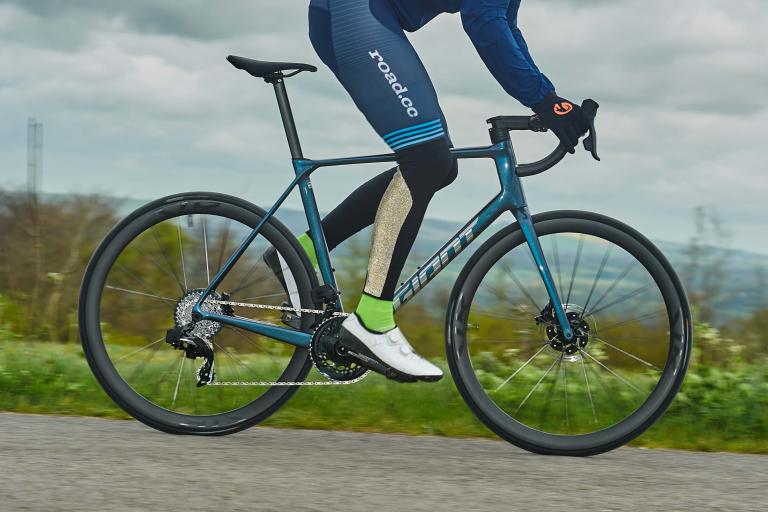

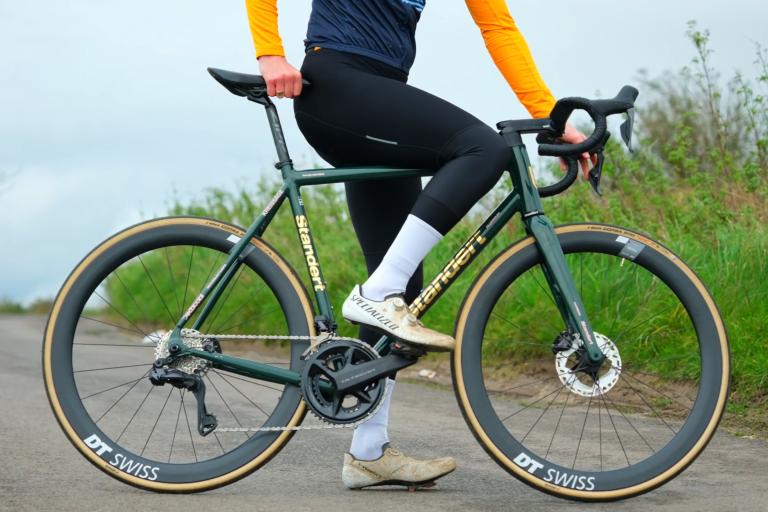
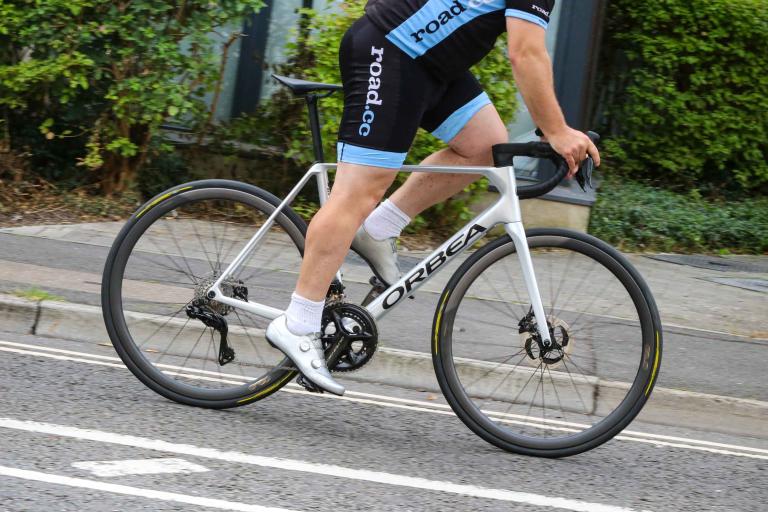
Add new comment
5 comments
When High isn't good enough: Modulus envy.
To be fair to Stevens they've been making the Izoard for while, it's been in their range since the 2010 model year so this is the fourth incarnation
You shouldn't, by rights, be able to claim dibs on a number either but Peugeot did that when Porsche released the 901. They claimed to have already established the use of 3 digit naming conventions with a 0 in the middle, and so the new Porsche was renamed as 911.
Basically, Wilier could argue that their Izoard has been about for a few years already and this new Izoard could cause confusion and steal sales. Seems bizarre that Stevens would even want to try to use the name, because they'll just have to change it like Campag did with the Daytona, or Ford would if they ever unveiled a new sports coupe called the E-Type.
I'm not sure you can claim dibs on a mountain… saying that, Specialized are said to pay a royalty to Fuji to use the word 'Roubaix'
Has anyone told Wilier yet?